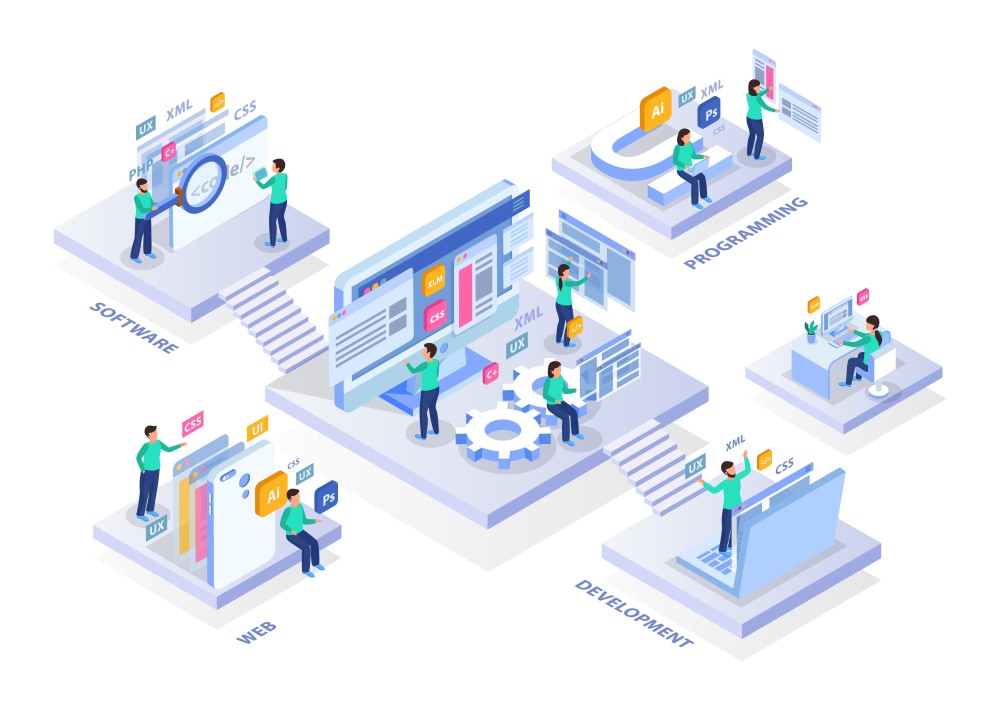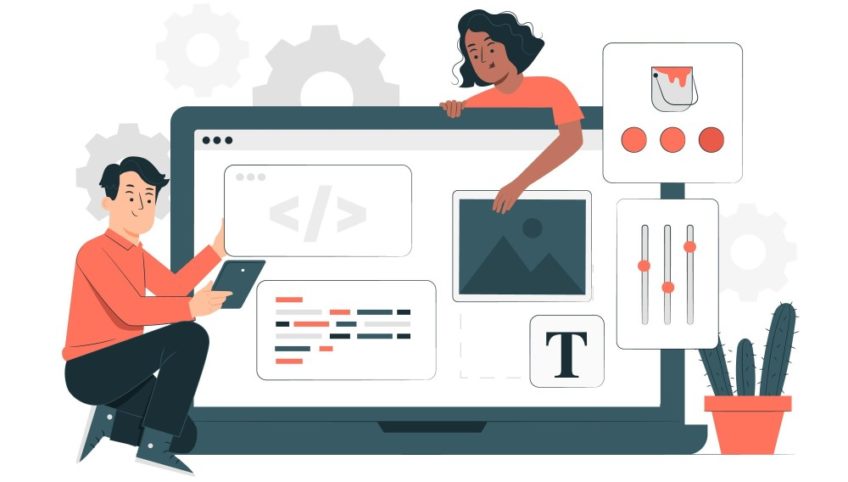A website is an assemblage of interlinked, publicly available Web pages that are linked by a single domain name. Individuals, groups, businesses, and organizations can construct and manage websites for a number of objectives. Educational sites, news sites, forums, social networking sites, e-commerce sites, and so on are just a few examples of websites. A website’s pages are often a combination of text and other material. However, there are no regulations prescribing how a website should look.
A website can be visited directly by typing its URL address into a browser or by using a search engine like Google or Bing to find it. Originally, websites were classified according to their top-level domains. Here are a few examples:
- For government agency websites, we use “.gov”.
- For educational institutions’ websites, we use “.edu”.
- We use “.org” for nonprofit organizations’ websites.
- “.com” is for the use of commercial websites.
- For information sites we have “.info” to use.
Tim Berners-Lee, a British scientist at CERN, built the first website in 1990. CERN declared three years later, in 1993, that anyone could freely browse and use the World Wide Web. The first web page address was http://info.cern.ch/hypertext/WWW/TheProject.html.
What does Web Development mean?
Web development is increasing and extending its sphere of influence. Web development is transforming fantasies into reality, from automating web interfaces to constructing mission-critical apps. Articles, guidelines, and case studies regarding web development, application development, and website design may be found in this area. Continue reading to get professional articles and perspectives on many topics of website creation and design.

Whether you want to employ or become a web developer, you need to be aware of the many forms of web development that developers can acquire.
These many forms of web development largely pertain to the various sectors of the profession in which web developers might operate — some of which we mentioned in the preceding sections. Some of these characteristics overlap, and web professionals frequently learn various forms of web development.
Front-end development:
Front-end developers work on the client-or user-facing side of websites, applications, and software – what clients see. They create visual features, such as structure, navigation, artwork, and other aesthetics. These developers’ primary responsibility is to create interfaces that assist users in achieving their objectives, which is why they frequently have a hand in the user experience side of their projects. Front-end developers with a background in customer experience might benefit from gaining empathy for end-users.
Back-end development:
The front-end is what users see, whereas the back-end is what they don’t. Back-end web developers work behind the scenes on the servers of websites, applications, and software to ensure that everything functions properly. These developers maintain the code for safety, information, and web pages in systems like routers, operating systems, APIs, and analytics. They work with front-end developers to make their goods available to users.
Full stack development:
Full-stack developers are responsible for both the front-end and back-end of a website. They may design a website, application, or software programme from beginning to end. The term “Stack” refers to the several technologies that manage distinct tasks on the same website, such as the server, interface, and so on. Because full stack developers must spend years in the industry to have the appropriate experience, this position is in high demand. Their broad expertise enables them to improve performance, detect problems before they arise, and assist team members in understanding the many components of a web service.
Desktop development:
Desktop developers create software apps that operate directly on your device rather than across the network in a browser. If an application can operate both online and offline, the competence of these developers may overlap with that of web developers.
Mobile development:
Apps for mobile devices such as smartphones and tablets are created by mobile developers. Mobile applications work in a very different way than other websites and software programmes, necessitating a distinct set of development talents as well as an understanding of specific programming languages.
Game development:
Game developers specialise in developing code for video games, including console games like Xbox, PlayStation, and so on, and mobile games. Hence, this expertise intersects with android development in certain ways. Game developers, on the other hand, specialise in creating game experiences, which requires a whole different skill set. Game developers, on the other hand, specialise in creating game experiences, which requires a whole different skill set.
Embedded development:
Embedded developers deal with any gear that isn’t a computer. This comprises electrical interfaces, consumer gadgets, Internet of Things devices, real-time systems, and other components. With the recent increase of networked products such as smart appliances, Bluetooth technology, and virtual assistants, embedded development is becoming a popular method.
Security development:
Security developers provide strategies and procedures for ensuring the safety of a software programme or website. These developers often operate as ethical hackers, attempting to “break” websites in order to uncover flaws without malicious intent. They also create technologies that detect and eliminate security issues.
The life cycle of web development
Despite popular belief, the fundamental component of website creation and design is not required for the coding process. Indeed, technologies such as HTML, CSS, and JavaScript shape the web and dictate how we interact with information. The stages of initial information collection, thorough planning, and post-launch maintenance, on the other hand, frequently remain behind the scenes while being a critical component of the website development life cycle.
- Gathering Information
- Planning and plotting
- Creating design
- Writing and assembling content
- Coding
- Testing, review and launch
- Repair and upkeep
Here is an elucidation of the cycle of web development:
Information Gathering:
This stage, the discovery and research stage, dictates how the succeeding phases will appear. At this point, the most essential duty is to have a clear grasp of your prospective website’s aims, the major goals you want to achieve, and the intended audience you want to attract to your site. This sort of website development survey assists in the construction of the finest plan for future project management.
The appearance of a news portal differs from that of an entertainment website, and online services for teens differ from those for adults. Diverse sorts of web pages offer different functionality to users, which means that different techniques should be employed for different objectives. A well-described and thorough strategy based on this pre-development data will safeguard you from investing significant resources in unanticipated difficulties like design changes or adding functionality that wasn’t originally envisaged.
Planning and plotting:
The developer generates the data that allows a client to determine how the full site will appear at this step of the web development cycle. The sitemap is built based on the information acquired in the previous step.
Creating design:
Your website takes form throughout the design process. At this stage, all visual material, such as pictures, photographs, and videos, is generated. Once again, all of the information obtained during the first phase is critical. While creating a design, keep the consumer and target audience in mind. The website layout is the work of a designer. It might be a graphic sketch or a finished graphic design. The layout’s major purpose is to reflect the information structure, illustrate the material, and show basic functions. Colours, logos, and pictures are included in layouts, which might provide a rough concept of the future product.
Following that, the customer can inspect the layout and provide feedback to you. If the customer is unsure about some areas of your design, modify the layout and resubmit it to him. This cycle should continue until the buyer is entirely happy.
Writing and assembling content:
Writing and assembling content generally overlaps with other stages of website development, and its importance cannot be overstated. At this stage, you must write out the substance of what you want to communicate to your website’s audience and include calls to action. Content writing also entails creating eye-catching headlines, text editing, composing new content, assembling old text, and other time-consuming and labour-intensive tasks. In most cases, the customer agrees to offer website material that is ready to move to the site. It is preferable if all website material is given prior to or during website development.
Coding:
You may now start working on the website itself. Graphic components created during earlier phases should be utilised to construct a real website. Typically, the main page is generated first, followed by all sub-pages, in accordance with the website structure, which was previously prepared in the form of a sitemap. Frameworks and CMS should be utilised to guarantee that the installation and configuration go smoothly on the server.
All static web page components designed throughout the mock-up and layout construction process should be produced and tested. Then, further features and interactions should be included. At this stage, you must have a thorough grasp of every website development tool that you want to utilise.
Testing, review, and launch:
Testing is most likely the most regular aspect of a process. Every other connection should be verified to ensure that none of them is broken. You should examine every form, script, and use spell-checking software to look for probable errors. Use code validators to ensure that your code adheres to current web standards. Valid code is required, for example, if cross-browser compatibility is important to you.
It’s time to submit your website to a server after you’ve double-checked it. To do this, FTP (File Transfer Protocol) software is utilised. After you’ve deployed the files, run one last test to ensure that all of your files were successfully installed.
Care and upkeep:
What you should keep in mind is that a website is more like a service than a commodity. It is not sufficient to “present” a website to a user. You should also ensure that everything works well and that everyone is content, and you should always be prepared to make modifications in the future.
What you should keep in mind is that a website is more like a service than a commodity. It is not sufficient to “present” a website to a user. You should also ensure that everything works well and that everyone is content, and you should always be prepared to make modifications in the future.
Another critical aspect is keeping your website up to date. If you use a CMS, you should update it on a regular basis to avoid problems and reduce security threats.



































